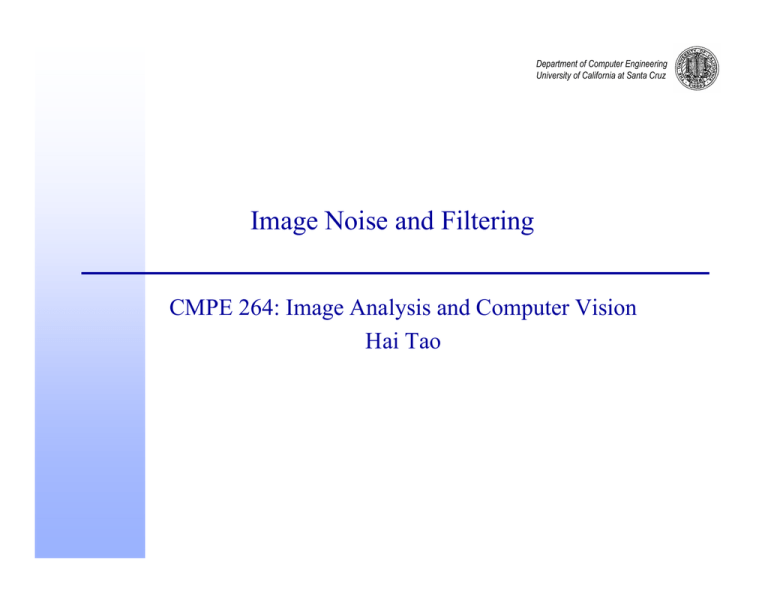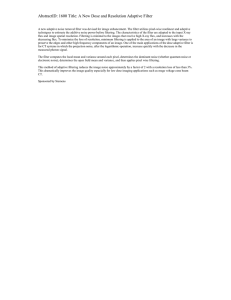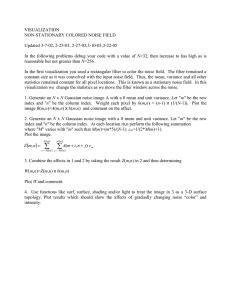Image Noise and Filtering
advertisement

Department of Computer Engineering
University of California at Santa Cruz
Image Noise and Filtering
CMPE 264: Image Analysis and Computer Vision
Hai Tao
Department of Computer Engineering
University of California at Santa Cruz
Estimating acquisition noise
Q
Q
Noise introduced by imaging system
Simple model
• Assumption: noise at each pixel is independent, characterized by
its mean and standard deviation
• Estimating the mean and the standard deviation σ for each pixel
For each i, j = 0,..., N − 1, let
1 N −1
I (i, j ) = ∑ I k (i, j )
N k =0
1/ 2
⎛ 1 N −1
2⎞
σ (i, j ) = ⎜
∑ ( I k (i, j ) − I (i, j )) ⎟
⎝ N − 1 k =0
⎠
• For most imaging system, σ ≈ 2.5
Department of Computer Engineering
University of California at Santa Cruz
Estimating acquisition noise
Q
Estimating auto-covariance
• In reality, the noise in neighboring pixels is not independent
• The correlation is described by auto-covariance
• If we assume auto-covariance of noise is the same everywhere in
the image, then
Let N i ' = N − i '−1, N j ' = N − j '−1, for each i ' , j ' = 0,..., N − 1, compute
1 N N
CII (i ' , j ' ) = 2 ∑ ∑ ( I k (i, j ) − I (i, j ))( I k (i + i ' , j + j ' ) − I (i + i ' , j + j ' ))
N i =0 j =0
i'
j'
• Example: How to compute CII (2,1) for a 10x10 image ?
N i ' = 7, N j ' = 8, for each i ' = 2, j ' = 1, compute
1 7 8
CII (2,1) = 2 ∑ ∑ ( I k (i, j ) − I (i, j ))( I k (i + i ' , j + j ' ) − I (i + i ' , j + j ' ))
10 i =0 j =0
Department of Computer Engineering
University of California at Santa Cruz
Estimating acquisition noise
Q
Auto-covariance for a typical imaging system. Notice that
the covariance along the horizontal direction, which is a
characteristic often observed in CCD cameras
Department of Computer Engineering
University of California at Santa Cruz
Modeling image noise
Q
Additive noise model
Random noise n(i, j ) added to pixel value I (i, j )
Iˆ(i, j ) = I (i, j ) + n(i, j )
Q
Signal-to-noise ratio (SNR), often expressed in decibel
SNR =
σs
σn
σs
SNRdB = 10 log10 ( )
σn
Q
σs
= 100
20 dB means
σn
Department of Computer Engineering
University of California at Santa Cruz
Modeling image noise
Q
Gaussian noise -white Gaussian, zero-mean stochastic
process
• White – n(i,j) independent in both space and time
• Zero-mean – I (i, j ) = 0
• Gaussian - n(i,j) is random variable with distribution
p ( x) =
Q
1
e
σ 2π
−
x2
2σ 2
Impulsive noise – also called peak, spot, or salt and pepper
noise, caused by transmission errors, faulty CCD sites, etc.
⎧ I (i, j )
I sp (i, j ) = ⎨
⎩ I min + y ( I max − I min )
x<l
x≥l
x, y ∈ [0,1] are two uniformly distributed random variables
Department of Computer Engineering
University of California at Santa Cruz
Modeling image noise
Q
Example: Gaussian
noise and salt and
pepper noise,
l=0.99
Department of Computer Engineering
University of California at Santa Cruz
Filtering noise - denoise
Q
Q
Q
Goal: recover I (i, j ) from Iˆ(i, j ) = I (i, j ) + n(i, j )
Methods: linear filtering and nonlinear filtering
Linear filtering: replace the original pixel by the weighted
sum of its neighboring pixel. The weights are the filter
coefficients
I : original image
A : filter kernel, size m × m
m/2
I A (i, j ) = I ∗ A = ∑
m/2
∑ A(h, k ) I (i − h, i − k )
h=− m / 2 k =− m / 2
Department of Computer Engineering
University of California at Santa Cruz
Mean filter – smoothing by averaging
Q
Q
The basic assumption is that the noise has higher
frequency and the signal has lower frequency. Noise can
be canceled by low-pass filtering
A averaging filter with m=5 is
Aavg
Q
⎡1
⎢1
1 ⎢
= ⎢1
25 ⎢
⎢1
⎢⎣1
1 1 1 1⎤
1 1 1 1⎥
⎥
1 1 1 1⎥
⎥
1 1 1 1⎥
1 1 1 1⎥⎦
Why does it work ?
• Explanation in spatial domain: reduce standard deviation by 5
• Explanation in frequency domain: suppress high frequency
components since F ( I ∗ A) = F ( I ) F ( A)
Department of Computer Engineering
University of California at Santa Cruz
Gaussian filter
Q
The Fourier transform of a Gaussian
kernel is also Gaussian, better lowpass filter than averaging filter
G (h, k ) = e
Q
−
h2 +k 2
2σ 2
Gaussian kernel is separable, which
means 2D Gaussian filtering can be
implemented as two 1D Gaussian
filtering
m/2
IG = I ∗ G = ∑
m/2
∑ G (h, k ) I (i − h, i − k )
h=− m / 2 k =− m / 2
m/2
= ∑
m/2 −
∑e
h=− m / 2 k =− m / 2
m/2
= ∑ e
h=− m / 2
−
h2
2σ 2
h2 +k 2
2σ 2 I (i
m/2 −
∑e
k =− m / 2
− h, i − k )
k2
2σ 2
I (i − h, i − k )
Department of Computer Engineering
University of California at Santa Cruz
Gaussian filter
Q
SEPAR_FILTER
• Build a 1-D Gaussian filter g, of width σ g = σ G
• Convolve each row of I with g, yielding a new image Ir
• Convolve each column of Ir with g, yielding a new image IG
Q
Construction of Gaussian filter
• In order to subtend 98.76% of the area in the Gaussian function,
for a given σ , the width of the filter need to be five times of σ ,
or w = 5σ
• Integer filter: Gaussian filter can be implemented efficiently by
converting the real numbers into rational numbers with a common
denominator: scale the filter so that the smallest components are
1s, replace the other entries with the closest integers
Department of Computer Engineering
University of California at Santa Cruz
Gaussian filter
Q
Example
• Filter image with Gaussian
noise
• Filter image with salt and
pepper noise
Department of Computer Engineering
University of California at Santa Cruz
Nonlinear filtering
Q
Median filtering
• Algorithm MED_FILTER
• For each pixel I(i,j) and its n × n neighborhood,
- Sort its neighboring pixels {I (i + h, i + k ) | h, k ∈ [−n / 2, n / 2])}
- Assign the median value to I(i,j)
• Example: with window/mask size 3× 3
22 17 102 105 106
21 21 100 99 102
22 17 102 105 106
21 21 99 102 102
19 22 20 102 102
24 21 97 101 104
19 18 101 108 101
19 21 97 102 102
24 21 97 101 104
19 18 101 108 101
Department of Computer Engineering
University of California at Santa Cruz
Median filtering
Q
Example with Gaussian noise
• Preserve discontinuity in the
signal.
• No contribution from pixels
with large noise
• Expensive to compute
Department of Computer Engineering
University of California at Santa Cruz
Homework
Q
Use Matlab to complete the following experiment
• Read in a gray-level image
• Add Gaussian noise to the image with σ = 10
• Implement
- 5 by 5 Separable Gaussian filter with σ = 0.8
- 5 by 5 Median filter
• Turn in
- Matlab code for adding noise and the two filtering algorithms
- The original image, the image with noise, and the filtering
results
- Derivation of the discrete Gaussian filter






